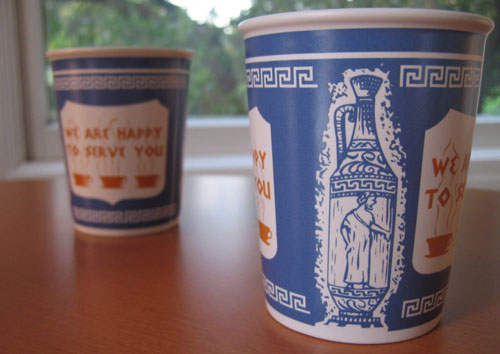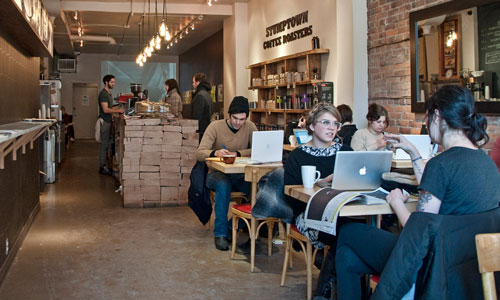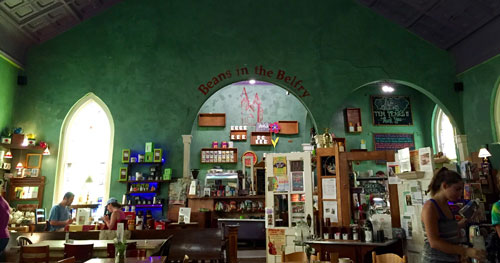Clouds In My Coffee
Coffee shops are our community centers, and if handled right, coffee culture can be full of just as much richness as whatever they put in your Anthora cup.
"I would go into the Med and I would see somebody with a blue serge suit on and a big wig—it was Ginsberg, and I would say 'Hello, how you doing?' He was standing around a group of people sitting there, all talking intensely. I saw him lots over a period of two to three years."
— Berkeley, California resident and local activist Brad Cleaveland, reflecting on the scene at the Caffe Mediterraneum, an independent coffee shop that's been continuously operating for roughly 60 years. The Med, as the locals call it, is known for a few particular claims to fame: One, it's the spot where onetime regular Allen Ginsberg is said to have written much of his masterwork Howl, and two, it was used during a scene in The Graduate. But for coffee geeks, the most important is probably the third: The fact that the shop, while still named Piccolo, is said to be the birthplace of the caffe latte.

(Dan Bluestein/Flickr)
Five coffee culture terms that are confusing as heck to Folgers fans
- "Third-wave coffee": If you're a ska or emo fan, you kinda have a vague idea of what this means, but here's a basic explanation for people whose experience with coffee is limited: The first wave of coffee was about the mass production of coffee, the second wave focused on the idea of "good" coffee and the rise of the coffee house, and the third wave was all about the character of the coffee itself, and less about the marketing involved. (In other words, it ain't about chains.) As Craft Beverage Jobs points out, there may even be a fourth wave of coffee on its way, as the third-wave standouts grow into major chains themselves.
- "Bird-friendly": This term, invented by the Smithsonian Institute and coming with its own unique standard, describes coffee that's grown under the shade of a native tree, rather than in the sunlight or under another kind of canopy. The term is somewhat controversial, as it competes with a number of other standards, including the Rainforest Alliance's sustainable agriculture program. There is even a coffee club focused on bird-friendly coffee, because of course there is.
- "Turkish coffee": A regional variation on coffee that relies on beans ground into a fine powder, then boiled in a small container. (The grounds aren't filtered out, by the way.) The challenge with Turkish coffee, of course, is that many countries around Turkey—including Bosnia, Cyprus, Greece, and Armenia—have claimed it as their own variation.
- "Anthora cup": The iconic Greek-inspired cup variation that you run into at any number of New York City coffee hawkers. This is not something you'll run into in your average hipster locales, but it's become a widely respected piece of coffee ephemera, so popular that Solo had to bring back the design after the public clamored for it. The cup comes in ceramic form these days.
- "Clover machine": This machine, originally built by the Coffee Equipment Company of Seattle with a price tag of $11,000, was quickly snapped up by Starbucks in 2008. Starbucks' purchase of the company left indie coffee shops out in the cold when they couldn't get parts for the machine, which is effectively a very high-end, automated version of an Aeropress. To give you an idea of the complexity around both the machine and Starbucks' supply chain, it took the company more than five years to figure out how to make it fit in their stores. Not to be outdone in the technological arms race, the indie shops have something called a Poursteady, which automates the process of making a pourover.

(Eric Parker/Flickr)
Can laptops coexist with casual conversation at coffee shops?
A couple months ago, frustrated with the District's coffee culture, I wrote a bit of a rant on Medium in response to a move by a local coffee hub to block laptops on the weekends.
I basically pointed out that (in my view) the real problem with DC's coffee culture wasn't the laptops, but the fact that the shops hosting coffee fans appeared to be unwelcoming, failing to make time or room for the community elements that the strongest coffee shops thrive from. (I mentioned Fair Grounds prominently, because of course I did.)
"Maybe it’s because they heard about them on Yelp or Foursquare, but people get in bubbles around their experiences, not using these spaces as ice-breaking opportunities," I wrote.
For the most part, the rant got a positive response. But there were a handful of folks who were more cynical about the whole mess, sneering at the very idea that laptops weren't the cause of this problem.
So, being who I am, I packed those negative comments away and wondered if there was any research about this—whether the so-called "third place" was really all it was cracked up to be. Now, I wrote about Ray Oldenburg's "third place" concept back in the fall, when I made a weird argument that Barnes & Noble should convert its format to that of a for-profit library.
But it's worth asking: Has anyone actually tested whether coffee shops are actually sticking with their supposed mission in the WiFi era?
As it turns out, yes, someone actually has tested this theory. In "The Social Transformation of Coffee Houses: The Emergence of Chain Establishments and the Private Nature of Usage," a 2013 academic article published in the International Journal of Social Science Studies, three West Virginia University researchers (Rachael A. Woldoff, Dawn Marie Lozzi, and Lisa M. Dilks) tested the idea of how technology changed up the coffee experience. They compared a number of Boston-area coffee shops to see whether they were properly adhering to the third-place concept, or if laptops (or, in the case of Starbucks, the chain-shop decor) was sucking the air out of the room.
What they found was somewhat surprising: The researchers observed that a Starbucks in Boston's Central Square adhered most closely to the third-place concept. ("This Starbucks had a distinguishing feature that no other coffee house in this study had: friendly baristas," the researchers wrote.)
However, of the six places they tested, four of them found a happy medium between technology and conversation. Just one coffee shop they researched, the 1369 Coffee House in Central Square, failed to be socially welcoming. Furthermore, the researchers found that the mixture of laptops and groups of people actually complemented one another pretty well, despite Oldenburg's arguments that such a mixed environment didn't work.
"According to Oldenburg such a multifunctional space is a 'hostile habitat' that actually harms socializing because productivity dominates social activities," the study stated. "However, our observations suggest that this view may be overstated. Socializing was still a large part of each multifunctional space with both small and large groups engaging in conversation."
Ultimately, though, the researchers argued that Starbucks is a place to work, while indie shops are generally a place to chat.
"Amenities, ample seating, and spatial arrangement are highly conducive to attracting customers to come in and stay for long periods of time. In such environments, people can complete a variety of tasks at a relatively low cost and with no time limitations," the trio wrote. "In general, Starbucks provided customers with conveniences geared towards productivity, such as power outlets, Wi-Fi, and media resources while independently-owned coffee houses offered amenities that encourage conversing with others, like seating arrangements designed for socializing, enjoying a novel atmosphere, and uniqueness."
Ultimately, the challenge that laptops and technology devices create is that their experiences can shut us off from the wider world. But the coffee shops that do the best with this complication are the ones that figure out this balance between productivity and culture.
The reason why folks come to a coffee house is often because they want both. Often, they get neither.
"There is no particular need to rewrite prayers and statements, but there is an urgent necessity to transform platitudes into redemptive words of salvation by acting them out in life."
— The Rev. Malcolm Boyd, offering his philosophy on person-to-person evangelizing in a 1961 New York Times interview. Boyd, who died last year, was famously known as the "Espresso Priest," for being one of the first preachers to practice primarily outside of traditional venues like churches. Instead, he worked out of coffee shops and nightclubs, at one point opening for comedian Dick Gregory. His approach was controversial among mainline preachers, but he won a lot of fans for his down-to-earth approach. (He also publicly came out as gay in the '70s, using his notoriety to help ensure that "young gays won't go through the suffering I did.") Boyd's work set the stage for coffee shops that are run by churches, a phenomenon that picked up in the late '60s and is still common today. Some church coffee shops have been open for more than 50 years.
A couple weeks ago, the wife and I found ourselves unsure of the next adventure we wanted to take. We had a long Memorial Day weekend, and thought there'd be too much traffic if we went south.
So we went north, with the eventual goal of crossing the West Virginia border to check out Harpers Ferry for the first time. And we almost made it.
(Joe Flood/Flickr)
But instead, we ended up in a coffee shop about 10 miles away from the West Virginia border. The coffee shop, in a converted church, was deep in the middle of small-town Maryland. (It had a great name, too: "Beans in the Belfry.") The stained glass on the windows was still there, and there was no air conditioning to speak of that day. But it was the perfect spot to get away.
The wife and I played a card game for a little while (she won, twice), we mostly ignored our phones, and we got a chance to take in the sights. Eventually, a band showed up, built a makeshift stage, and started playing covers of Ricky Nelson and Johnny Cash songs. We never made it to Harpers Ferry—instead, we found contentment at a coffee shop.
I'm pretty sure that at one point during the three or four hours that we were there, I said something along the lines of, "wow, this place reminds me of Fair Grounds."
Thanks for setting my high water-mark, Elliot. After I moved away, I may not have gotten down to the coffee shop you started as much as I would've liked while you were still alive, but I've been looking for what you helped build at that coffee shop ever since.
You did a lot of good for a community full of people. You'll be greatly missed.
:format(jpeg)/2018/01/axs6ixptinagzibd8dwa.gif)
/2018/01/axs6ixptinagzibd8dwa.gif)


/uploads/ernie_crop.jpg)